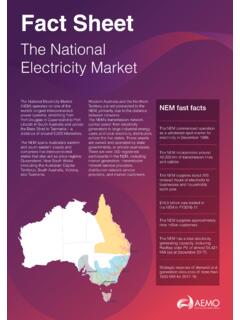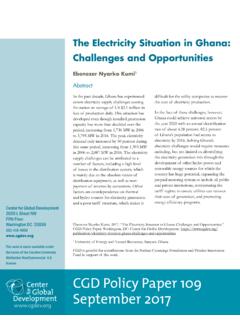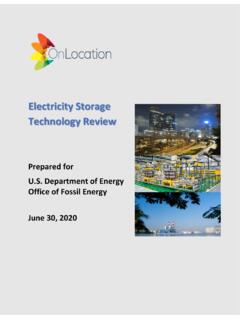Transcription of Integrating Variable Renewable Energy Into the Grid ... - …
1 Integrating Variable Renewable Energy into THE GRID: KEY ISSUESGREENING THE GRIDGRID INTEGRATION TERMINOLOGYB alancing area: the collection of generation, transmission, and loads within the metered boundaries of the responsible entity ( , the balancing authority) that maintains balance between electricity supply and demand within this value: the contribution of a power plant to reliably meet demand, measured either in terms of physical capacity (kW, MW, or GW) or as a fraction of the power plant s nameplate capacity (%).Flexibility: the ability of a power system to respond to changes in electricity demand and response: voluntary (and compensated) load reduction used as a system reliability resource. Grid integration of Renewable Energy : the practice of power system planning, interconnection, and operation that enables efficient and cost-effective use of Renewable Energy while maintaining the stability and reliability of electricity integration study: an analysis of a set of scenarios and sensitivities that seeks to inform the stakeholders on the ability and needs of a power system to accommodate significant : technologies capable of storing electricity generated at one time and for use at a later Renewable Energy (VRE): electricity generation technologies whose primary Energy source varies over time and cannot easily be stored.
2 VRE sources include solar, wind, ocean, and some hydropower generation technologies. Variability: the changes in power demand and/or the output of a generator due to underlying fluctuations in resource or load. Uncertainty: the inability to perfectly predict electricity demand and/or generator foster sustainable, low-emission development, many countries are establishing ambitious Renewable Energy targets for their electricity supply. Because solar and wind tend to be more Variable and uncertain than conventional sources, meeting these targets will involve changes to power system planning and operations. Grid integration is the practice of developing efficient ways to deliver Variable Renewable Energy (VRE) to the grid. Good integration methods maximize the cost-effectiveness of incorporating VRE into the power system while maintaining or increasing system stability and considering grid integration, policymakers, regulators, and system operators consider a variety of issues, which can be organized into four broad topics: New Renewable Energy generation New transmission Increased system flexibility Planning for a high RE Renewable Energy GENERATIONP ower system planners can secure and sustain investment in new VRE generation by aligning targets and incentives with grid integration considerations.
3 Long-term, aspirational Renewable Energy targets establish a vision that can drive innovation in the policies and system operations that support clean Energy . Also critical are grid-aware incentives ( , rewarding wind and solar generators that incorporate technologies that contribute to grid stability), which both motivate investment in Renewable Energy and mitigate negative impacts of Integrating these resources to the grid. As planners consider scaling up VRE generation, the inherent variability of wind and solar resources complicates evaluations of whether a system with significant VRE has adequate supply to meet long-term electricity demand. A variety of approaches exist for estimating the capacity value of VRE, as well as techniques that enable utilities and power system operators to use wind and solar to reliably meet electricity distributed photovoltaic (PV) solar power results in unique benefits and challenges compared to the integration of utility-scale wind and solar power.
4 Significant localized growth in PV can raise concerns such as voltage violations and reverse power flow in low-voltage distribution systems. However, various studies have shown that positive impacts ( , reduced line losses and avoided generation costs) can also result Greening the Grid aims to modernize the power system so that it can accommodate large-scale integration of Variable Renewable Energy resources. Photo from iStockPhoto 17755781 and illustration from iStockPhoto Variable Renewable Energy into THE GRID: KEY ISSUES from distributed PV. Updating interconnection standards, procedures, and distribution planning methodologies to better reflect the characteristics of distributed PV can help realize these benefits and delay or even prevent the need for grid reinforcement. NEW TRANSMISSIONS caling up VRE generation requires grid expansion and upgrades so that power systems can access high-quality solar and wind resources, which are often remote from existing transmission networks.
5 A well-crafted combination of policies, rules, and procedures encourages investment in large-scale transmission expansion. These measures not only improve the utilization of VRE, but also potentially defer the need for network refurbishment. INCREASED SYSTEM FLEXIBILITYA ccessing sources of operational flexibility becomes increasingly important in systems with significant grid-connected solar and wind Energy . System operating procedures and market practices especially the implementation of real-time forecasting, faster scheduling, and ancillary services are often among the least-cost options for unlocking significant flexibility without significant investments in new physical infrastructure. Another important institutional flexibility option is operational coordination between balancing authority areas, which enables sharing of resources through reserve sharing, coordinated scheduling, and/or consolidated operation.
6 Other sources of flexibility include flexible conventional generation and transmission networks. Additionally, demand response and storage are emerging as tools for increasing flexibility at very high penetrations of VRE. Options for procuring flexibility vary based on the regulatory context. For vertically integrated utilities, contractual or policy mechanisms provide the primary basis for encouraging the uptake of flexibility measures. In contrast, partially or wholly restructured power markets motivate flexibility through incentives and market design mechanisms, such as sub-hourly dispatch, ancillary services markets, and price-responsive FOR A HIGH RE FUTUREIn any power system, planning activities include assessing long-range demand and evaluating options for expanding capacity and transmission. With the introduction of significant VRE generation, power system planning increasingly focuses on evaluating options for increasing flexibility across the power system.
7 Grid integration studies help establish the flexibility requirements and build confidence among investors and operators that the power system can be operated reliably at increased VRE levels. A grid integration study simulates the operation of the power system under various scenarios, identifies potential constraints to reliability, and evaluates the cost of actions to alleviate those constraints. Robust grid integration studies are based on significant stakeholder input, along with a broad set of foundational data. Although grid integration studies usually include production cost simulations to model unit commitment and economic dispatch, determining the system-wide costs of Integrating solar and wind power is much more challenging. The full costs and value of VRE assets to the power system depend on dynamic and complex interactions among these generators and a system s loads, reserves, thermal generators, and transmission integration studies illuminate the obstacles and opportunities that wind and solar integration could pose to a power system, helping to dispel grid integration myths and misperceptions that inhibit large-scale deployment.
8 These studies also lay the foundation for prioritizing and sequencing grid integration investments. Written by J. Katz and J. Cochran, national Renewable Energy Fact Sheets Scaling Up Renewable Energy Generation: Aligning Targets and Incentives with Grid Integration Considerations Using Wind and Solar to Reliably Meet electricity Demand Grid-Integrated Distrbuted Solar: Addressing Challenges for Operations and PlanningRelated Fact Sheets Grid Planning Methods for Expansion and UpgradesRelated Fact Sheets Sources of Operational Flexibility Methods for Procuring Power System Flexibility Balancing Area Coordination: Efficiently Integrating Renewable Energy into the Grid The Role of Storage and Demand ResponseRelated Fact Sheets Grid Integration Studies: Data Requirements What are the Costs of Managing a System with Significant VRE?
9 Wind and Solar on the Power Grid: Myths and MisperceptionsGreening the Grid provides technical assistance to Energy system planners, regulators, and grid operators to overcome challenges associated with Integrating Variable Renewable Energy into the MORE INFORMATIONJ ennifer Leisch USAID Office of Global Climate Change Tel: +1-202-712-0760 Email: Cochran national Renewable Energy Laboratory Tel: +1-303-275-3766 Email: the Grid is supported by the Government s Enhancing Capacity for Low Emission Development Strategies (EC-LEDS) program, which is managed by the Agency for International Development (USAID) and Department of State with support from the Department of Energy , Environmental Protection Agency, Department of Agriculture and Forest | NREL/FS-6A20-63033 May 2015













